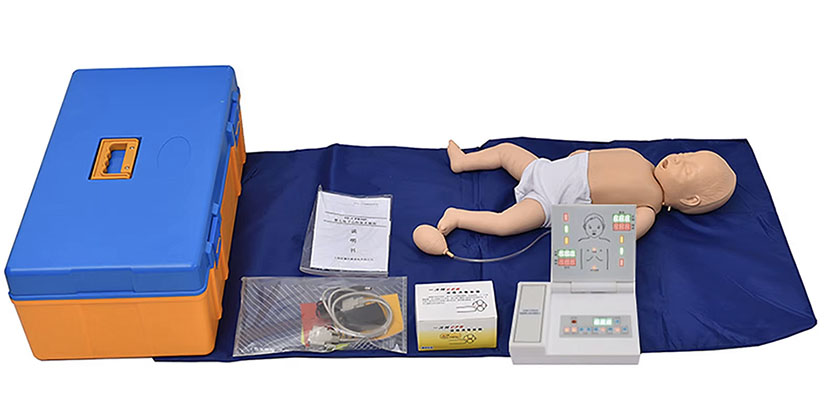infant cpr simulator KM/CPR160
First. Model installation process:
First baby simulator from the suitcase, the simulator and the monitor for the power line connection, and then the 220V500Ma/6V external voltage regulator and computer monitor for the connection, the regulator plug into the 220V power supply that is to complete all the wiring process.
Second, the operation of the function before setting and use
After completing the wiring process, that is, open the computer monitor on the power switch, press the start button, according to the operating frequency of 100-120 times / min, start the operation.
Third, during the operation, it is necessary to master the standardized actions and operational matters:
1、 Airway opening ----- infants due to ligamentous muscle laxity, so the head must not be tilted back excessively, so as not to cause respiratory reclosure due to excessive head extension, can be used with one hand to support the neck, to keep the airway straight, to form an open airway.
2. First, correct chest compressions for 30 times (because the infant's mouth and nose openings are small, and the position is very close, the operator can use his/her mouth to press against the opening of the infant's mouth and nose, and perform mouth-to-mouth and nose blowing operations). For correct manual mouth-to-nose blowing, the amount of tidal gas blown in was 30-50 ml, and the feedback of the correct amount of gas blown was indicated by a green digital light. Erroneous blowing is greater than 50 ml, the information feedback of blowing too much air is displayed by the yellow digital light. Error blowing too fast, in 0.27 seconds time blowing into the volume of air is greater than 30ml, the error of blowing too fast information feedback by the red digital display.
3, the correct and incorrect compression function prompts -------- (1) compression position: first of all, find the correct chest compression position, that is, the infant's chest two nipple line and sternum midline, for the correct compression area, the operator with two fingers or thumb in the correct compression area for chest compression, compression of the finger position of the incorrect information feedback by the red light digital display. (2) Pressing intensity: the correct depth of chest compressions is more than 40 mm, and the information feedback of the correct depth of compressions is digitally displayed by the green light. (2) Pressing intensity: the correct chest compression depth is more than 40mm, the information feedback of the correct pressing depth is displayed by the yellow digital light.
4、 Operation mode (training mode)
1. Put the baby supine on a hard surface or the operator will put the baby on the palm of the arm, in addition, the operator can also hold the baby's chest with two hands can be operated training. 2. According to the “2015 international cardiopulmonary resuscitation (CPR) and cardiovascular first aid (ECC) guide standard” to show the spirit of the spirit of the (1) single operation training or assessment according to the latest international standards of the chest compressions and artificial respiration (blowing) ratio is always 30:30. The ratio of chest compressions and artificial respiration (blowing) is always 30:2. Firstly, 30 effective artificial compressions are carried out, and then 30 correct chest compressions and 2 correct artificial mouth-to-mouth blowing are carried out according to the beeps of the operating frequency of 100-120 beeps/minute for 5 consecutive cycles of CPR, that is to say, the requirement of 30:2 of the international rescue standard is accomplished. (2) The ratio of chest compressions to artificial respiration (blowing) in accordance with the latest international standards is always 15:2. Firstly, perform effective manual compressions for 30 times, and then, according to the beeps of the operating frequency greater than 100 times/minute, perform correct chest compressions for 15 times, and correct artificial mouth-to-mouth blowing for 2 times for 5 consecutive cycles of CPR, i.e., completing the requirements of the international resuscitation standard of 15:2. Requirements. (3) Checking arm brachial artery pulsation, hand cupping the ball to simulate arm brachial artery pulsation.



